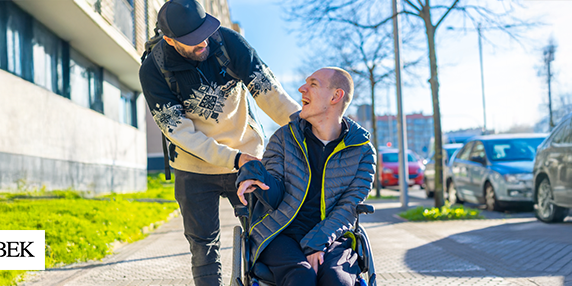When you or a loved one experiences mobility challenges, the home should be a place of comfort—not a source of worry. But everyday items like rugs, stairs, and poor lighting can quickly become fall hazards. During National Mobility Awareness Month, it’s the perfect time to talk about how small changes in your home can make a big impact on safety, independence, and peace of mind.
Whether you use a cane, walker, rollator, or manual wheelchair—or care for someone who does—these five tips can help you create a safer and more accessible living space.
1. Remove Common Trip Hazards Throughout the Home
Falls are one of the leading causes of injury for people with limited mobility, especially older adults. But many fall hazards are easy to fix once you know what to look for.
Do a room-by-room safety sweep and keep an eye out for:
- Loose area rugs that can shift or curl
- Electrical cords stretched across walking paths
- Clutter like shoes, bags, or small furniture blocking hallways
- Uneven floor transitions or loose tiles
How to fix it:
- Use non-slip rug pads or remove rugs altogether
- Tuck cords against walls or use cord covers
- Rearrange furniture to create wider, clearer pathways
- Repair or mark uneven surfaces
Bonus Tip:
Even with a clutter-free space, mobility aids provide added stability. Walkers, rollators, or canes can make navigating the home safer and easier—especially on hardwood or tile floors where slipping is more likely.
2. Improve Lighting in Hallways, Staircases, and Bathrooms
Dim lighting isn’t just inconvenient—it’s dangerous for anyone with limited mobility or impaired vision. Many falls occur at night when moving from bed to the bathroom or navigating stairs in low light.
Lighting safety tips:
- Install night lights in bedrooms, bathrooms, and hallways
- Use motion-activated lights to eliminate the need to fumble for switches
- Replace dim bulbs with bright, energy-efficient LEDs
- Add lighting at the top and bottom of staircases
- Use portable lamps for additional task lighting
Bonus Tip:
Some rollators come with built-in LED lights or storage compartments for flashlights, making it easier to stay safe and prepared—even on late-night bathroom trips.
3. Install Supportive Equipment in Key Areas
The bathroom, stairs, and even the kitchen can be tricky to navigate if you’re unsteady on your feet or use a wheelchair. Thankfully, there are easy-to-install tools that can make a big difference in safety and confidence.
Simple modifications that can help:
- Grab bars next to toilets, tubs, and showers
- Shower chairs or transfer benches to make bathing safer and easier
- Raised toilet seats for easier transfers
- Non-slip mats inside and outside the tub or shower
- Handrails for staircases or entrance steps
Why it matters:
These supportive tools help reduce the risk of slips and falls while increasing independence and dignity—especially in private spaces like the bathroom.
Bonus Tip:
If you or your loved one needs help selecting bathroom safety equipment, Doubek Medical Supply carries a wide range of reliable, easy-to-use products.
4. Choose the Right Mobility Aid for Your Needs
Choosing a mobility aid isn’t a one-size-fits-all decision. The right equipment depends on your level of stability, strength, lifestyle, and environment. A tool that works well indoors may not be ideal for outdoor use—and vice versa.
Let’s break it down:
- Canes: Great for light support or occasional balance issues
- Walkers: Offer more stability than a cane and often come with two or four legs
- Rollators: Walkers with wheels, brakes, and seats—perfect for longer walks or outdoor use
- Manual wheelchairs: Best for individuals with limited walking ability or those recovering from surgery
How to choose:
- Talk to your doctor or physical therapist for a recommendation
- Think about where you’ll use it most (indoor, outdoor, both?)
- Consider your storage, transportation, and travel needs
- Look for features that match your lifestyle (e.g., lightweight frames, folding designs, seats)
Bonus Tip:
At Doubek Medical Supply, our friendly, experienced team can help match you with the right mobility aid—so you can move with greater comfort and confidence.
5. Create a Clear, Accessible Living Space
Sometimes, the biggest improvement you can make is simply rearranging your space to suit your current needs. Whether you’re using a wheelchair or walker, it’s important to be able to move freely and safely through your home.
Home setup suggestions:
- Ensure hallways and doorways are wide enough for mobility devices
- Keep frequently used items (like kitchenware or clothing) at an easy-to-reach height
- Consider replacing round door knobs with lever handles
- Remove unnecessary furniture or décor that creates tight spaces
- Use furniture risers to adjust the height of chairs or beds for easier transfers
Bonus Tip:
Mobility tools like reacher/grabber tools or folding canes can make it easier to complete everyday tasks and navigate tight spaces.
Safe Living Starts with the Right Support
Mobility challenges can change the way you move through your home—but they don’t have to limit your independence. With the right tools and a few thoughtful adjustments, your home can become a safer, more accessible place where you or your loved one can thrive.
At Doubek Medical Supply, we understand that every person’s needs are unique. That’s why we offer a wide selection of walkers, rollators, canes, wheelchairs, and bathroom safety aids—plus personalized support to help you find the best solutions for your lifestyle.
Whether you’re outfitting your home for a loved one or shopping for yourself, we’re here to help every step of the way.
Browse our mobility products today:




